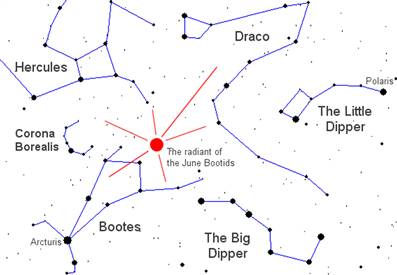Meteor Shower, Upcoming Annual Event |


  |
Meteor Shower, Upcoming Annual Event |
 Apr 21 2004, 12:26 AM Apr 21 2004, 12:26 AM
Post
#1
|
|
 Rock Bar!     Group: Members Posts: 715 Joined: 28-October 03 From: The 45th Parallel in Oregon Member No.: 16 |
Space Weather News
April 21, 2004 http://spaceweather.com Earth is passing through a stream of dusty debris from Comet Thatcher, the source of the annual Lyrid meteor shower. The best time to look is during the hours before dawn on Thursday, April 22nd, when the shower peaks. Lyrids appear to stream from the vicinity of the bright blue star Vega in the constellation Lyra high in the northern sky. This is not an intense shower, but some years it is pretty: northern sky watchers typically see between 5 and 25 meteors per hour. -------------------- |
|
|
|
 Apr 23 2004, 04:07 PM Apr 23 2004, 04:07 PM
Post
#2
|
|
 Master Mucker!      Group: Admin Posts: 7,187 Joined: 7-October 03 From: Colorado Member No.: 4 |
We have been having way to many clouds here in the past 3 days to see anything else in the sky. <_< I bet it was an awsome sight though. :)
-------------------- Education is the key to the future,
and participation opens the door to opportunity. Discover your prospecting independence & success! ColoradoProspector.com Owner/Webmaster Core team member ♥  |
|
|
|
 Jun 18 2004, 04:43 PM Jun 18 2004, 04:43 PM
Post
#3
|
|
 Rock Bar!     Group: Members Posts: 715 Joined: 28-October 03 From: The 45th Parallel in Oregon Member No.: 16 |
Space Weather News for June 18, 2004
http://spaceweather.com JUNE BOOTID METEORS: Earth is heading for a cloud of dust shed by Comet Pons-Winnecke in the 19th century. An encounter with the cloud might produce a pleasing meteor shower before sunrise on Wednesday, June 23rd. Or not. Forecasters aren't sure. If a shower materializes, sky watchers in western North America and across the Pacific Ocean are favored to see it. DOUBLE VENUS TRANSIT: On June 8th, in a tiny village in Slovakia, Tomas Maruska took a picture that is ... beyond rare. It shows the International Space Station transiting Venus while Venus was transiting the Sun. See it at http://SpaceWeather.com. On another note: A house sized Meteor just impacted in Australia striking the ground and creating a huge explosion seen many miles away.... |
|
|
|
 Jun 21 2004, 01:45 AM Jun 21 2004, 01:45 AM
Post
#4
|
|
 Rock Bar!     Group: Members Posts: 715 Joined: 28-October 03 From: The 45th Parallel in Oregon Member No.: 16 |
What to watch for
Western North America and the Pacific Ocean will still be in darkness at that time, and are favored with the best possible views. But should the activity last for many hours, then it could be worthwhile to carefully watch the sky from Tuesday night, June 22, on until the first light of dawn on Wednesday, June 23. Whether you plan to look for the June Bootids on the night of June 22-23 or again on the night of June 26-27, keep in mind that the constellation of Bootes will be excellently positioned as darkness falls. It will appear nearly overhead and high up in the northern sky and will remain in view through the night as it descends toward the northwest. Fortunately, the moon will be a rather wide crescent and will set just before midnight (local daylight time) on the night of June 22-23. It will, however, be more of a hindrance on the night of June 26-27 when it will have increased in brightness to a bright gibbous phase and not setting until after 1:30 a.m.
Attached image(s)

|
|
|
|
 Jul 23 2004, 04:47 PM Jul 23 2004, 04:47 PM
Post
#5
|
|
 Rock Bar!     Group: Members Posts: 715 Joined: 28-October 03 From: The 45th Parallel in Oregon Member No.: 16 |
Space Weather News for July 23, 2004
http://spaceweather.com Hours after a coronal mass ejection (CME) hit Earth's magnetic field on July 22nd, a geomagnetic storm began, sparking auroras over parts of North America. Sky watchers spotted Northern Lights as far south as Minnesota, Washington and Michigan in the United States. Some particularly nice purple auroras appeared over Wisconsin. The giant sunspot that triggered this activity is now crossing the middle of the sun and could unleash more strong solar flares and CMEs in the days ahead. Amateur astronomers using safe solar observing techniques should have no trouble seeing the 'spot, which is wider than the planet Jupiter. Visit Spaceweather.com for safe sunspot observing tips and up-to-date photos of auroras. |
|
|
|
  |
| Lo-Fi Version | Time is now: 27th April 2024 - 01:35 AM |